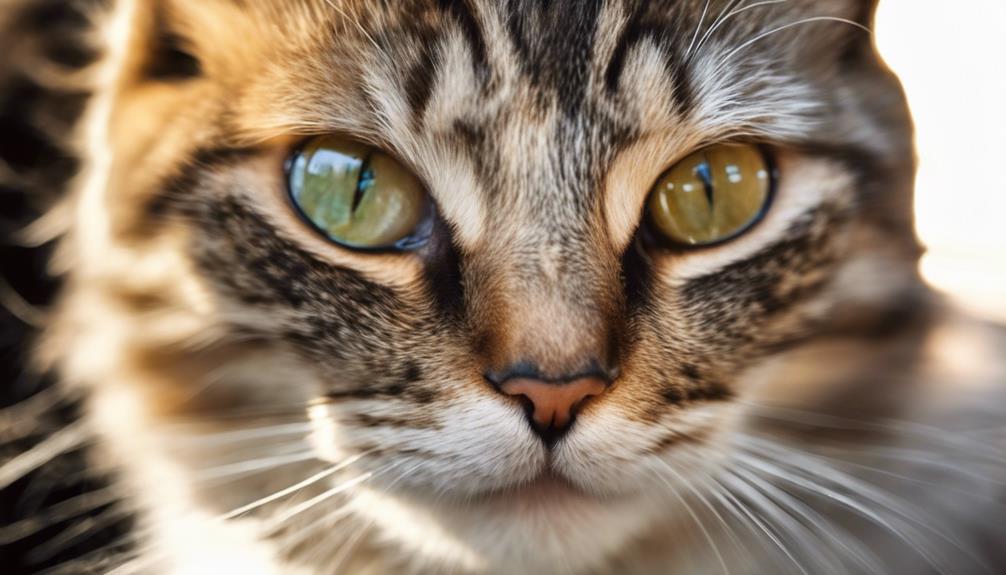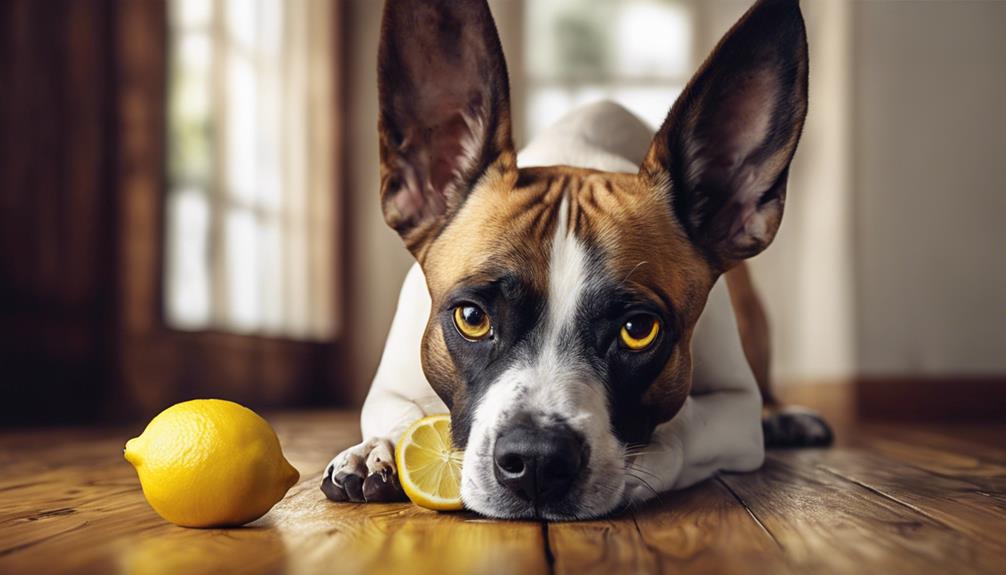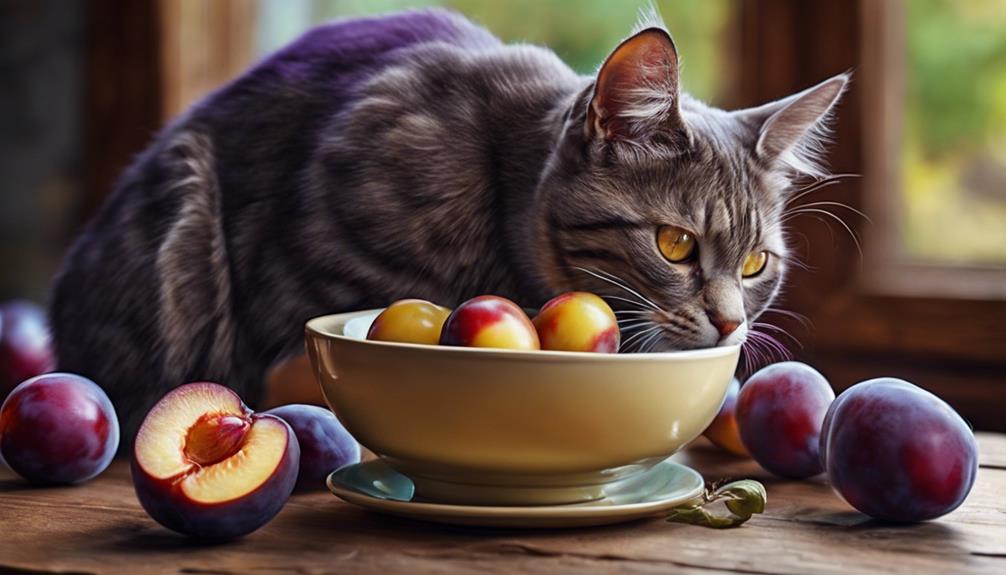When cats squint their eyes, it's a sign of potential discomfort or eye issues. Eye infections, foreign bodies, or even uveitis may cause this. Signs of pain include squinting, redness, and changes in behavior. Conjunctivitis, corneal ulcers, and glaucoma are common eye conditions. Watch for redness, discharge, or sensitivity to light. Seek vet care for foreign bodies. Help by gently cleaning and creating a calm environment. Consulting a vet before using eye drops is wise. Stay vigilant for any changes in their eyes. Remember, understanding these signs can lead to early detection and treatment for our feline friends.
Key Takeaways
- Cats squint their eyes due to pain, discomfort, or eye conditions.
- Squinting can indicate infections, foreign bodies, or allergies.
- Eye squinting in cats may be a response to bright light.
- Cats squint to protect their eyes from irritants or injuries.
- Squinting can signal a need for veterinary attention and care.
Common Causes of Cat Eye Squinting
When cats narrow their eyes, it's often due to a variety of typical reasons that include eye infections, foreign bodies, uveitis, and corneal ulcers. Eye issues in cats can be quite bothersome for our feline friends.
Eye infections, whether bacterial or viral, can result in redness, swelling, and narrowing as the eyes try to protect themselves. Foreign bodies like dust, dirt, or small particles can irritate the delicate structures of the eye, causing cats to narrow in response.
Uveitis, which is inflammation within the eye, not only impacts their vision but also triggers narrowing behavior. Corneal ulcers, resulting from scratches or trauma to the eye's surface, are also common causes behind cat narrowing, indicating potential eye damage.
Understanding these typical causes of cat eye narrowing can help us better care for our furry companions and prioritize their eye health at all times.
Signs of Pain in Cats Eyes
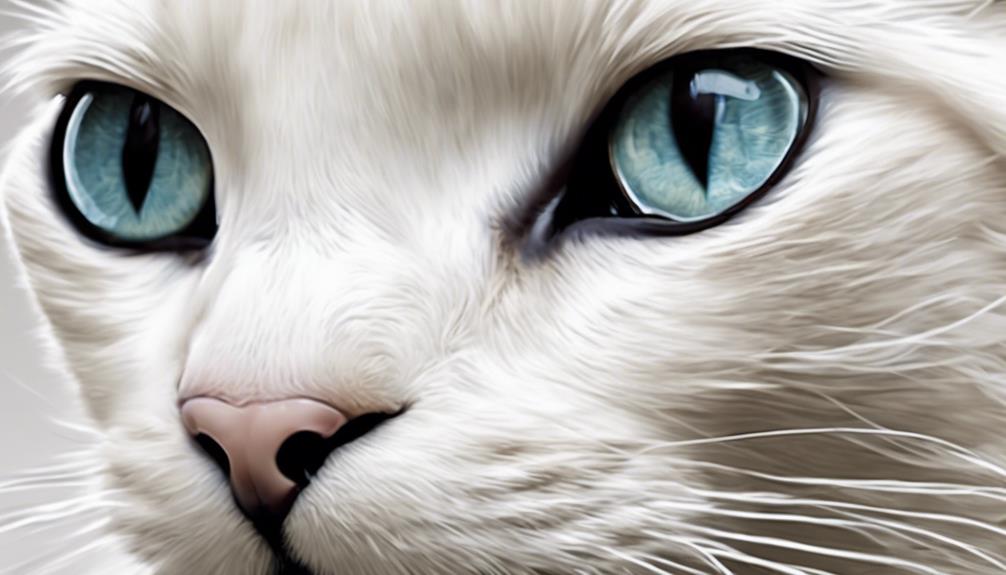
Cats experiencing pain in their eyes may display various signs such as squinting, excessive tearing, or redness. Additionally, changes in their behavior, like increased aggression or restlessness, can be indicators of eye discomfort. Some cats might paw at their eyes, rub their faces, or avoid bright light when in pain. Dilated pupils, sensitivity to touch around the eyes, or frequent blinking are also signs of discomfort or pain in their eyes. If you notice any of these signs, seeking veterinary evaluation promptly is crucial to address any underlying issues effectively.
| Signs of Pain in Cats Eyes |
|---|
| – Squinting |
| – Excessive tearing |
| – Redness |
Understanding and recognizing these signs can help you provide the necessary care and attention to your feline friend. Remember, your cat's well-being is a top priority, so always be vigilant and proactive in addressing any signs of pain or discomfort they may be experiencing.
Understanding Conjunctivitis in Cats
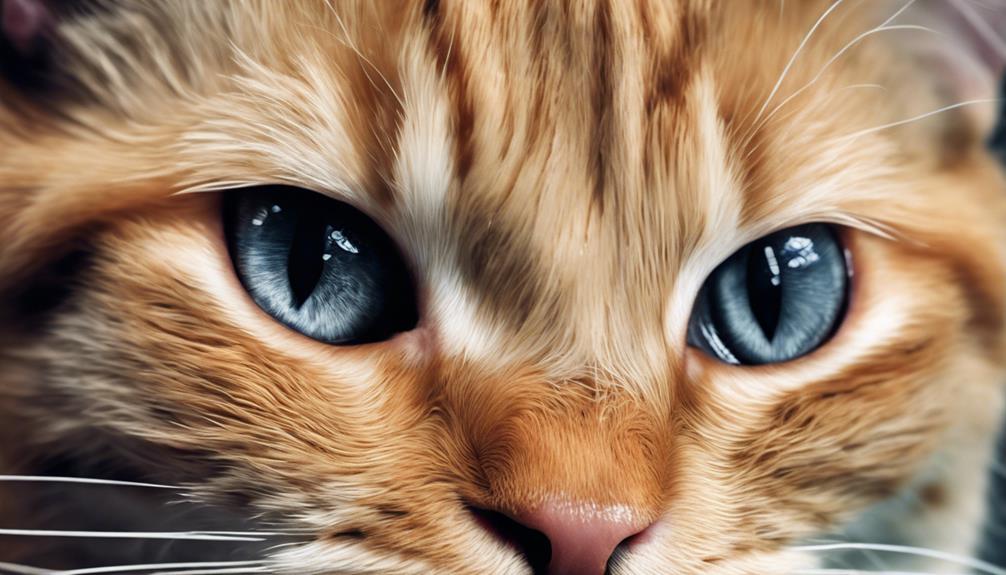
Upon noticing signs of pain in cats' eyes, such as squinting and excessive tearing, understanding conjunctivitis in cats becomes essential. Conjunctivitis is a common eye condition in cats characterized by redness, swelling, and discharge in the eye. This inflammation can be triggered by viral or bacterial infections, allergies, or irritants like dust or smoke.
If your feline friend is displaying watery or mucus-like discharge, squinting, or frequent blinking, it could be a sign of conjunctivitis. Prompt veterinary attention is vital to diagnose the underlying cause and begin appropriate treatment, which may involve antibiotic or antiviral eye drops and ensuring the eye is kept clean.
Addressing the root of the issue is crucial to prevent complications and guarantee your cat's eye health is restored. By being vigilant and seeking timely care, you can help your beloved pet recover from conjunctivitis and maintain their overall well-being.
Impact of Corneal Ulcers on Cats
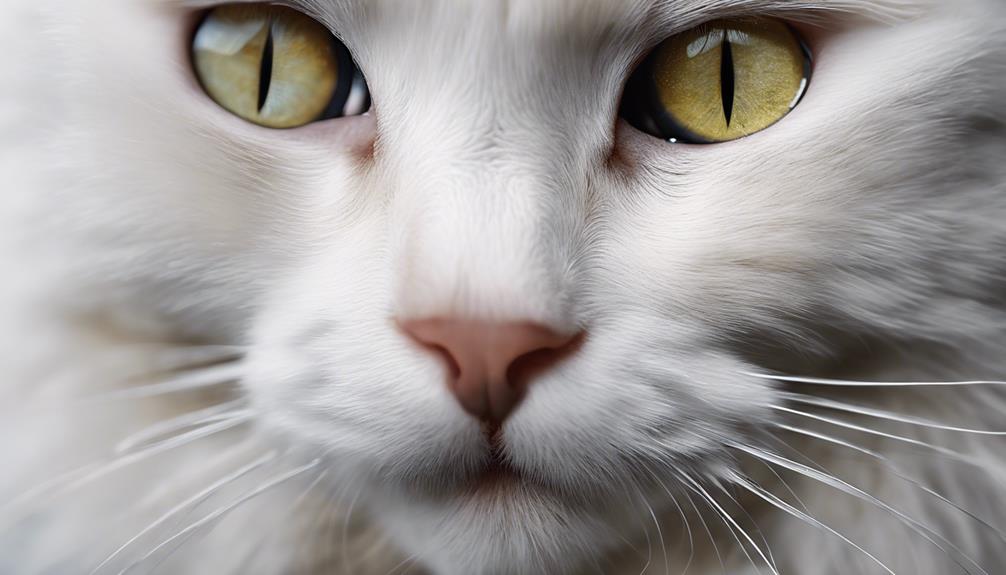
Experiencing corneal ulcers can cause significant discomfort and potential vision impairment for our feline companions. Here are three key points to ponder about the impact of corneal ulcers on cats:
- Vital Affliction: Corneal ulcers, often caused by infections or injuries to the cornea, can be agonizing for cats. They may exhibit signs of discomfort, such as excessive blinking, pawing at their eyes, or increased tear production.
- Vision Impairment: If left untreated, corneal ulcers can lead to cloudy eyes and even vision impairment in cats. These ulcers affect the transparency of the cornea, hindering the passage of light into the eye and potentially causing long-term damage.
- Treatment and Monitoring: Treatment for corneal ulcers typically involves prescribed medications and close monitoring by a veterinarian. Prompt intervention is critical to alleviate pain, prevent complications, and safeguard the cat's eye health. Regular check-ups are essential to make sure that the ulcers heal properly and that the cat's vision remains intact.
Glaucoma in Feline Eyes
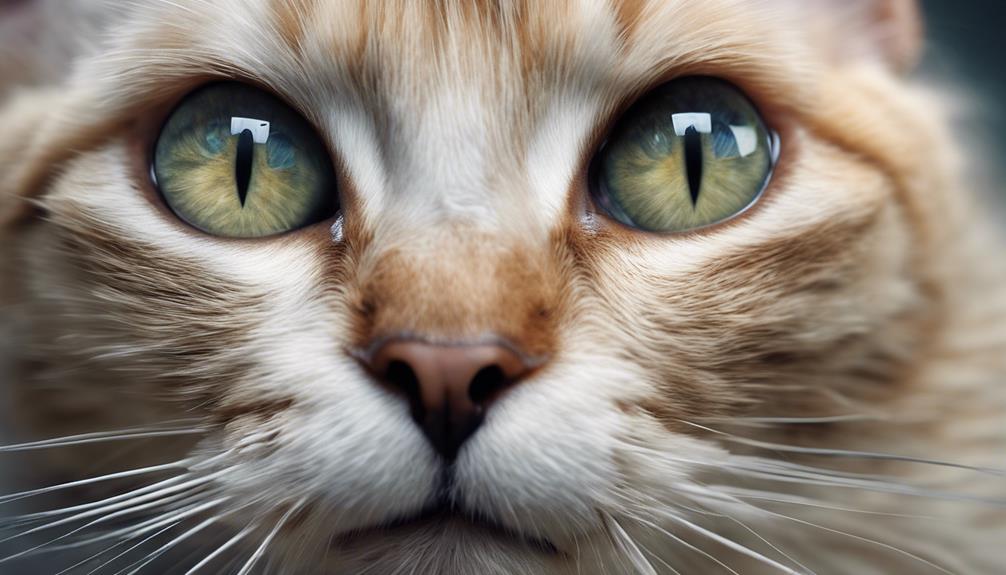
When cats develop glaucoma, it poses a critical threat to their vision and overall eye health, potentially leading to irreversible damage and blindness. Glaucoma is a condition that can cause elevated pressure within the eye, resulting in symptoms such as dilated pupils, eye pain, and cloudiness in the eyes. If you notice your feline friend showing signs of glaucoma, such as dilated pupils that may indicate discomfort or excitement, it's essential to seek immediate veterinary attention. Delay in diagnosis and treatment can lead to permanent vision loss.
Veterinary intervention is necessary to manage glaucoma effectively and preserve your cat's eye health. Prompt diagnosis and appropriate treatment are essential to prevent further complications and maintain your cat's quality of life. Remember, early detection and intervention play a significant role in managing glaucoma and minimizing its impact on your cat's eyesight. Stay vigilant and seek professional help if you suspect your cat may be suffering from this serious condition.
Dealing With Bacterial Eye Infections
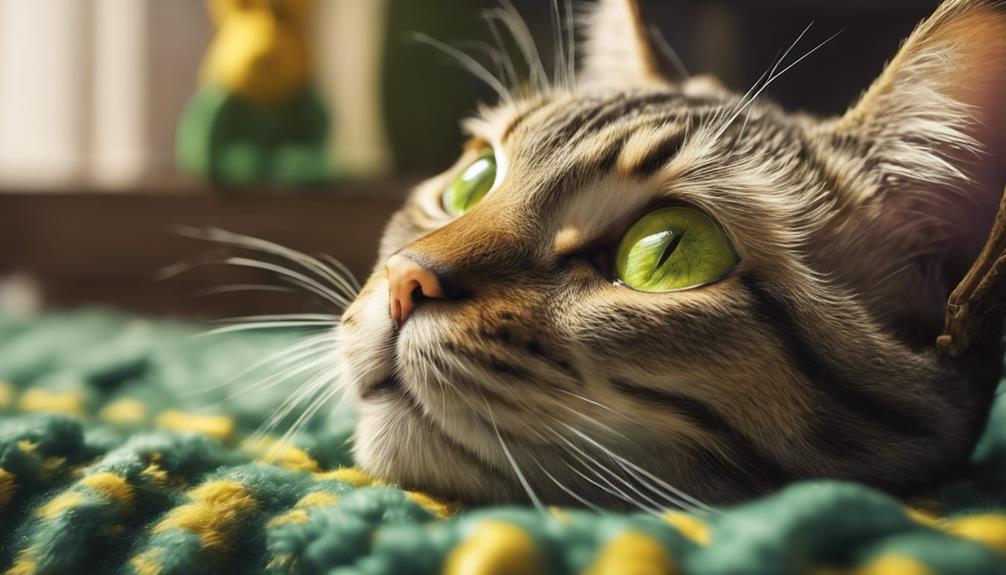
Facing bacterial eye infections in cats can be worrisome, as they're often caused by bacteria like Chlamydia or Mycoplasma. When dealing with these infections, here are some essential points to keep in mind:
- Prompt Diagnosis: If you notice your cat squinting, experiencing redness, or having discharge from their eyes, it's important to seek veterinary care promptly. Early detection is key to effective treatment.
- Antibiotic Treatment: Veterinarians typically prescribe antibiotic eye drops or ointments to combat bacterial eye infections in cats. Administering these medications as directed is crucial for a successful recovery.
- Preventing Complications: Untreated bacterial eye infections can lead to more severe issues like corneal ulcers. By following your vet's recommendations and monitoring your cat's progress, you can help prevent complications and ensure a speedy recovery.
Viral Infections in Cats Eyes

Viral infections in cats' eyes, such as Feline Herpesvirus, commonly cause eye squinting and other related symptoms. Feline Herpesvirus, a prevalent culprit, can lead to conjunctivitis, resulting in redness, discharge, and light sensitivity.
These infections are often spread through direct contact with infected felines or contaminated objects. If your cat is showing signs of eye squinting or discomfort, it's important to seek veterinary care promptly. Treatment for viral infections may involve antiviral medications, supportive care, and symptom management to alleviate your furry friend's discomfort.
Regular check-ups and vaccinations are essential preventive measures to safeguard your cat against these viral infections that can trigger eye squinting. Remember, early intervention and proper care are key to helping your cat recover from viral eye infections like Feline Herpesvirus.
Allergy-Related Eye Squinting in Cats
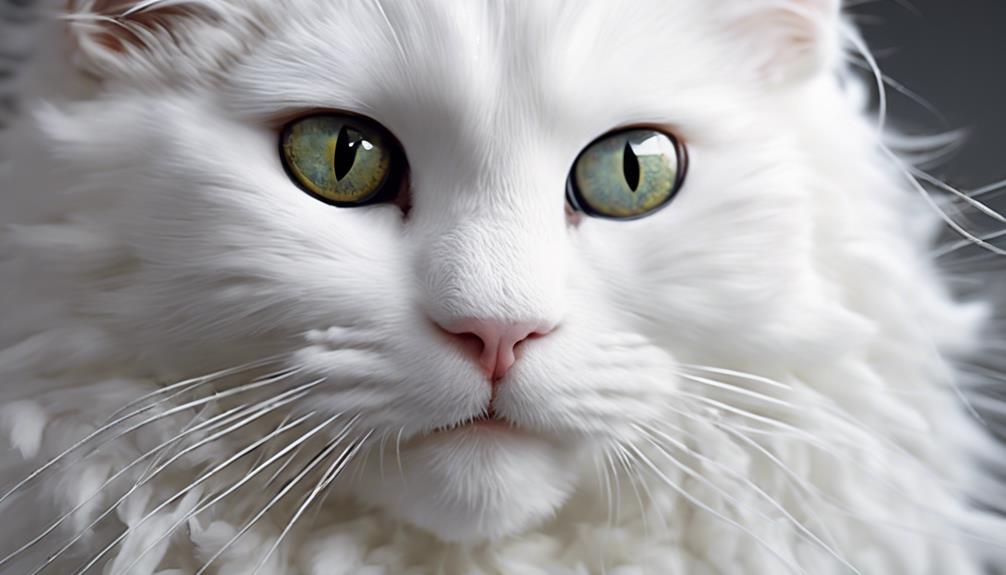
Allergies can be a common trigger for eye squinting in cats, often caused by environmental factors like pollen or dust. When a cat's eyes are affected by allergies, they may display symptoms such as redness, discharge, and discomfort.
Identifying specific allergens through blood tests and managing allergies with dietary changes can help alleviate squinting and improve a cat's eye health.
Allergy Triggers in Cats
When cats experience allergic reactions, their eyes may squint due to environmental triggers like pollen, dust, and mold. Allergies in cats can lead to uncomfortable eye squinting, causing irritation and distress.
Here are three common allergy triggers in cats to watch out for:
- Pollen: Pollen from flowers and plants can enter the cat's eyes, leading to allergic reactions and squinting.
- Dust: Dust particles in the air or on surfaces can trigger allergies in cats, resulting in eye squinting and discomfort.
- Mold: Mold spores present in damp environments can cause allergic reactions in cats, manifesting as eye squinting and other symptoms.
Understanding these allergy triggers can help you create a more comfortable environment for your feline friend.
Treatment Options Available
To effectively address allergy-related eye squinting in cats, veterinary consultation for diagnosis and the consideration of treatment options are essential steps. When it comes to treating your cat's eye squinting caused by allergies, your veterinarian may recommend antihistamines or steroid medications. It's important to identify the specific allergen triggering the squinting to tailor the treatment effectively. Regular check-ins with the vet are important to monitor your cat's response to the chosen treatment plan. Additionally, managing environmental factors that may be exacerbating your cat's allergies can help reduce the frequency of eye squinting episodes. Below is a table summarizing common treatment options for allergy-related eye squinting in cats.
| Treatment Options | Description |
|---|---|
| Antihistamines | Help alleviate allergic reactions |
| Steroid Medications | Reduce inflammation and itching |
Effects of Eye Inflammation in Cats
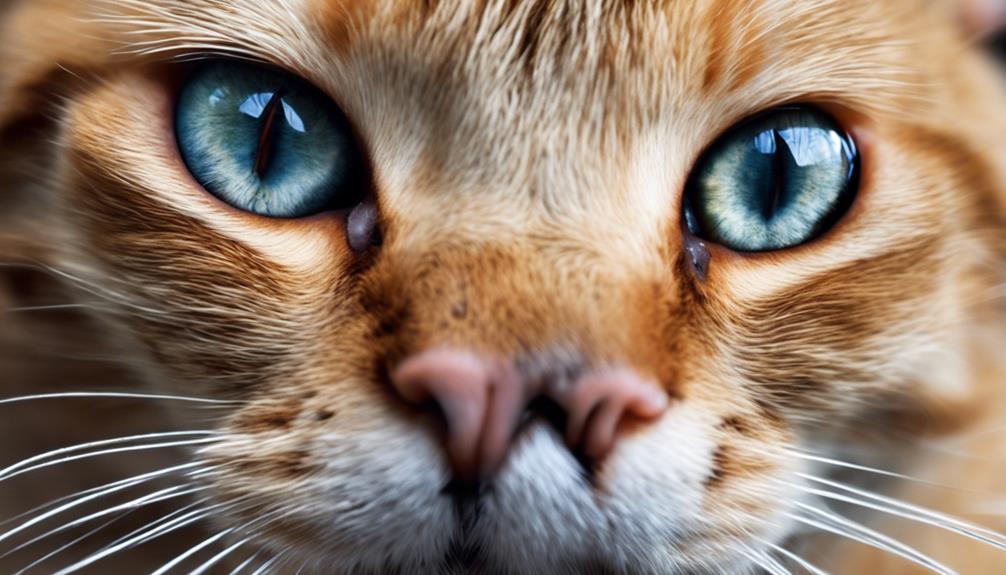
When cats experience eye inflammation, they may show signs such as redness, swelling, and discharge from their eyes. This discomfort can lead to squinting, excessive tearing, or pawing at the eyes.
Understanding the symptoms and treatment options for eye inflammation in cats is important for ensuring their well-being and preserving their vision.
Eye Inflammation Symptoms
During episodes of eye inflammation in cats, redness, swelling, and discharge may manifest as visible symptoms. Here are three signs to watch for when it comes to eye inflammation in our feline friends:
- Redness: Cats' eyes may appear more red than usual, indicating inflammation or irritation.
- Swelling: Swelling around the eyes can be a sign of inflammation, suggesting a need for prompt attention.
- Discharge: Any unusual discharge from the eyes, such as pus or excessive tearing, could indicate an underlying issue requiring veterinary care.
Recognizing these symptoms promptly can help guarantee our beloved cats receive the necessary care to address any eye inflammation effectively.
Treatment Options
For cats experiencing eye inflammation, treatment options typically involve prescribed eye drops or ointments. If your cat is squinting due to eye inflammation, it's important to consult a veterinarian promptly.
These medications help reduce inflammation, alleviate discomfort, and promote healing. In more severe cases, oral medications or antibiotics may be necessary to combat the underlying causes of the inflammation.
Regular monitoring and follow-up appointments are critical to track the progress of the treatment and make sure your cat's eyes are improving. Untreated eye inflammation can lead to vision impairment or more serious eye conditions in cats, so addressing the issue promptly is crucial.
Cat Eye Communication Behavior
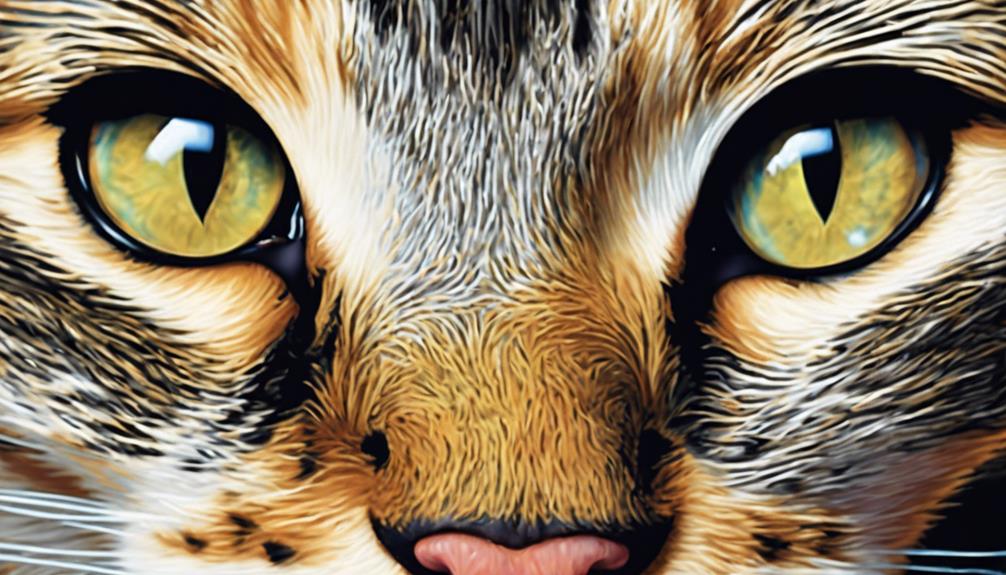
Exploring cat eye communication behavior reveals a fascinating insight into feline emotions and social interactions. Cats use their eyes to express a wide range of feelings, from affection to contentment. Here are three intriguing aspects of cat eye communication:
- Squinting Shows Affection: When your cat squints at you, it's a sign of trust and love. This behavior signifies that your feline friend feels safe and comfortable in your presence.
- Non-Verbal Communication: Cats often communicate through body language, and squinting is a powerful non-verbal cue. By understanding this behavior, you can better interpret your cat's emotions and respond accordingly.
- Building Trust: Mutual blinking between cats and humans can strengthen the bond between them. By reciprocating your cat's squints and blinks, you're actively engaging in a form of communication that enhances trust and connection in your relationship. Understanding and responding to your cat's eye communication can deepen the emotional connection you share.
Checking Your Cats Eyes at Home
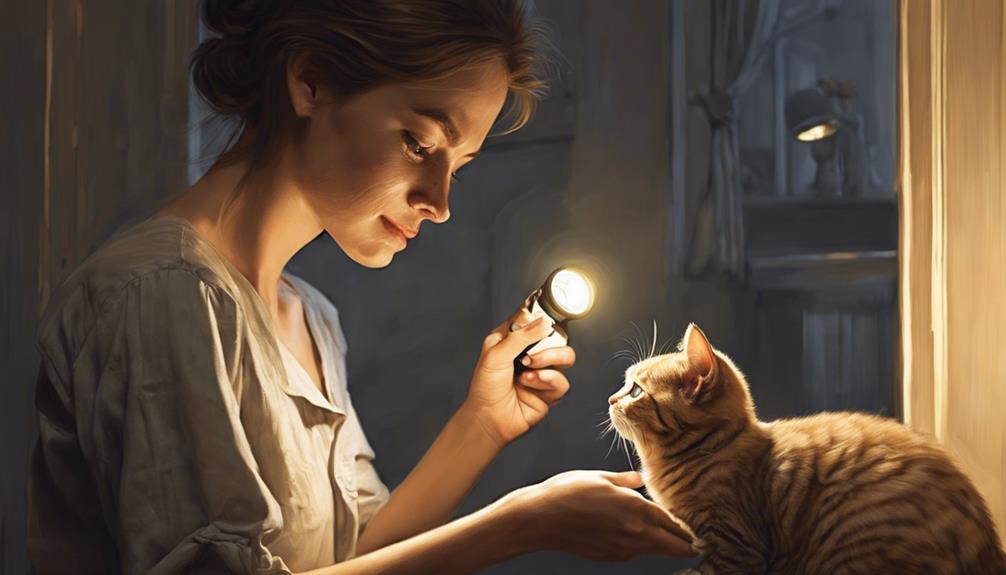
Regularly inspecting your cat's eyes at home is essential for maintaining their overall health and well-being. By taking a few minutes to check for any signs of squinting, discharge, redness, or swelling, you can catch potential issues early.
Keep an eye on your cat's behavior too; if you notice excessive blinking, pawing at the eyes, or sensitivity to light, it could indicate a problem. Changes in the eye's appearance, like cloudiness, should also be monitored as they may signal an underlying concern.
Creating a calm and comfortable environment for these inspections is key to helping your cat feel relaxed and cooperative. If you spot persistent squinting or any unusual symptoms, don't hesitate to seek veterinary attention promptly.
Your vigilance and care can go a long way in ensuring your feline friend's eye health and overall well-being.
Cat Eye Trauma and Squinting
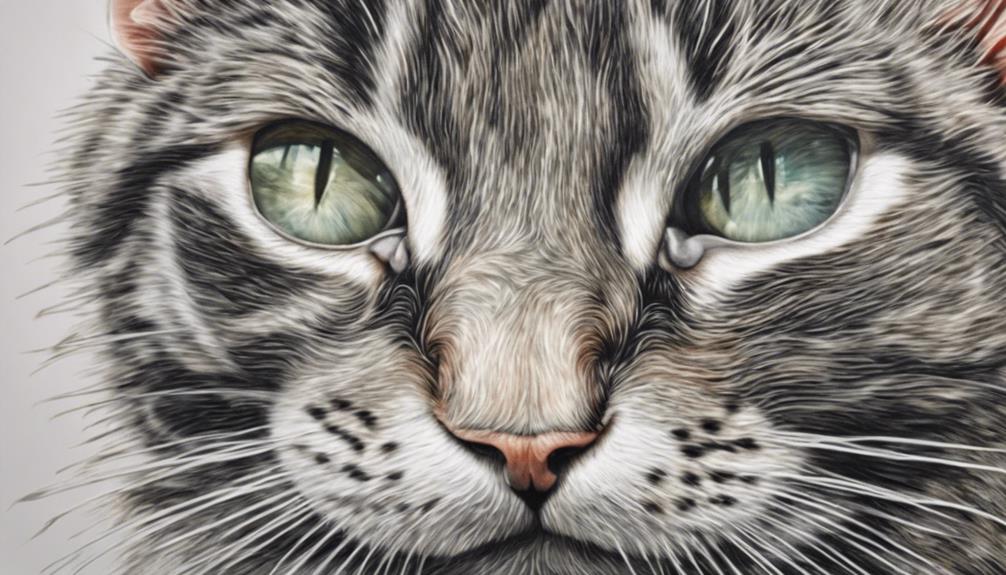
Eye trauma in cats can lead to squinting as a result of injuries to the eye, often caused by fights, accidents, or foreign objects. Signs of eye trauma may include squinting accompanied by swelling, discharge, or redness.
If your cat is squinting due to trauma, immediate veterinary attention is vital to prevent further damage and guarantee proper treatment.
Causes of Squinting
Injuries to a cat's eye can often lead to squinting behavior, indicating potential trauma or damage.
When it comes to the causes of squinting in cats, eye infections are a common culprit, causing discomfort and discharge.
Additionally, foreign bodies in a cat's eye can lead to irritation and squinting behavior, as the eye tries to protect itself.
Uveitis, which involves inflammation in the eye, can also result in cats squinting.
These various factors can all contribute to why your feline friend may be squinting, highlighting the importance of promptly addressing any issues with their eyes to safeguard their health and well-being.
Signs of Eye Trauma
When a cat experiences eye trauma, it can exhibit signs such as redness, swelling, discharge, and sensitivity to light, indicating potential injury or damage. Sometimes, swollen eyes can be a sign of importance, as cats may squint when they are content or feeling particularly loving towards their human companions. However, in the case of eye trauma, these signs should not be taken lightly. If you notice your feline friend displaying these symptoms, it's essential to seek prompt veterinary care. In the table below, we summarize the common signs of eye trauma in cats:
| Signs of Eye Trauma |
|---|
| Redness |
| Swelling |
| Discharge |
Treatment Options Available
Upon evaluating the cat's eye trauma and squinting, our veterinary team will suggest suitable treatment options depending on the root cause. Here are three key aspects of the treatment process:
- Veterinary Assessment: A thorough examination by a veterinarian is essential to determine the extent of the eye trauma and identify any underlying issues.
- Medications and Eye Drops: Depending on the diagnosis, treatment may involve the administration of medications or eye drops to alleviate symptoms and promote healing.
- Surgical Intervention: In more severe cases, surgical intervention may be necessary to repair damage or remove foreign bodies causing the eye trauma.
Recognizing Cat Eye Infections
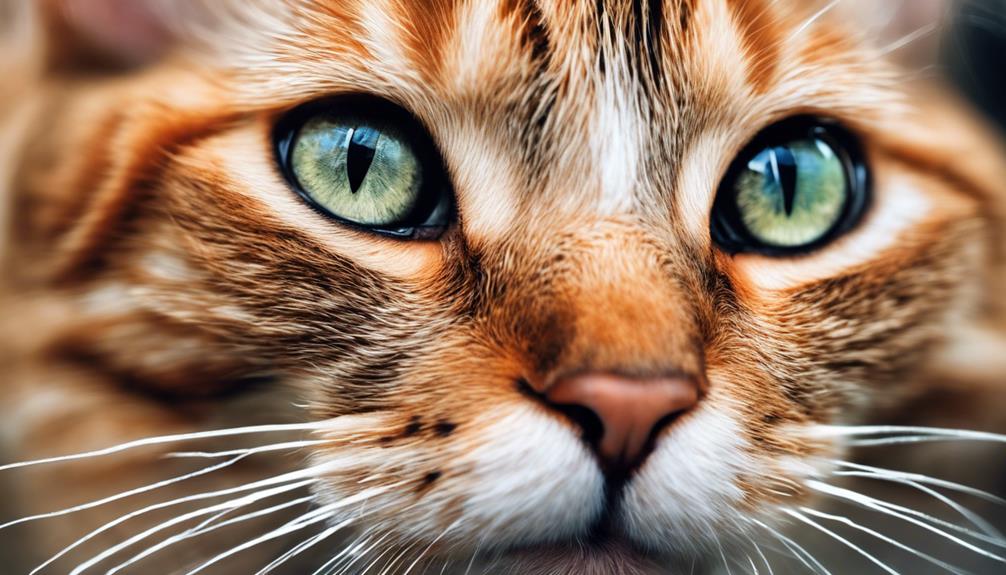
Cat eye infections can manifest through various noticeable symptoms, such as redness, discharge, and squinting in one or both eyes. When our feline friends experience eye infections, they may also display signs like watery eyes, pawing at the eyes, and sensitivity to light. These infections can be caused by bacteria or viruses, leading to conditions like conjunctivitis, which result in squinting and discomfort. One common culprit is the feline herpesvirus, known to cause eye infections in cats, with symptoms including squinting, ulcers, and even respiratory issues.
To help you recognize these signs more easily, here's a helpful table:
| Symptoms | Description |
|---|---|
| Redness | Eyes appear red and inflamed |
| Discharge | Presence of pus or watery discharge |
| Squinting | Partially closing one or both eyes |
| Watery eyes | Excessive tearing or watery discharge |
| Sensitivity to light | Discomfort or pain in bright light |
Being aware of these symptoms and seeking prompt veterinary care is essential to make sure your furry companion receives the appropriate treatment and avoids potential complications.
Dealing With Foreign Bodies in Cat Eyes
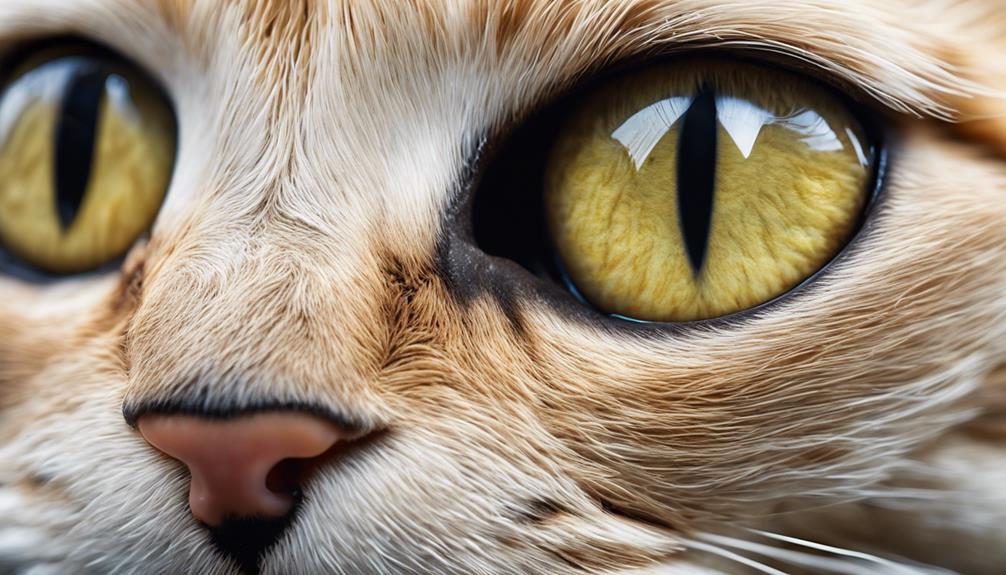
Identifying and promptly addressing foreign bodies in a cat's eyes is essential to prevent discomfort and potential eye damage. When dealing with foreign bodies in cat eyes, here are three key points to keep in mind:
- Recognize the Signs: Watch out for signs of irritation such as excessive tearing, redness, or squinting. Cats may paw at their eyes or rub their faces against surfaces when they've a foreign body in their eyes. Being attentive to these signs can help you address the issue promptly.
- Seek Veterinary Attention: Immediate veterinary attention is vital when foreign bodies are suspected in a cat's eyes. Professionals have the necessary tools and expertise to safely remove the foreign object without causing further harm to the delicate eye structures.
- Avoid Self-Removal: It's important to resist the urge to remove foreign bodies from your cat's eyes yourself. Trying to do so without proper knowledge and tools can lead to additional injuries or complications. Trusting the expertise of a veterinarian is the best approach to make sure your cat's eye health is preserved.
Steps to Help a Cat With Eye Discomfort
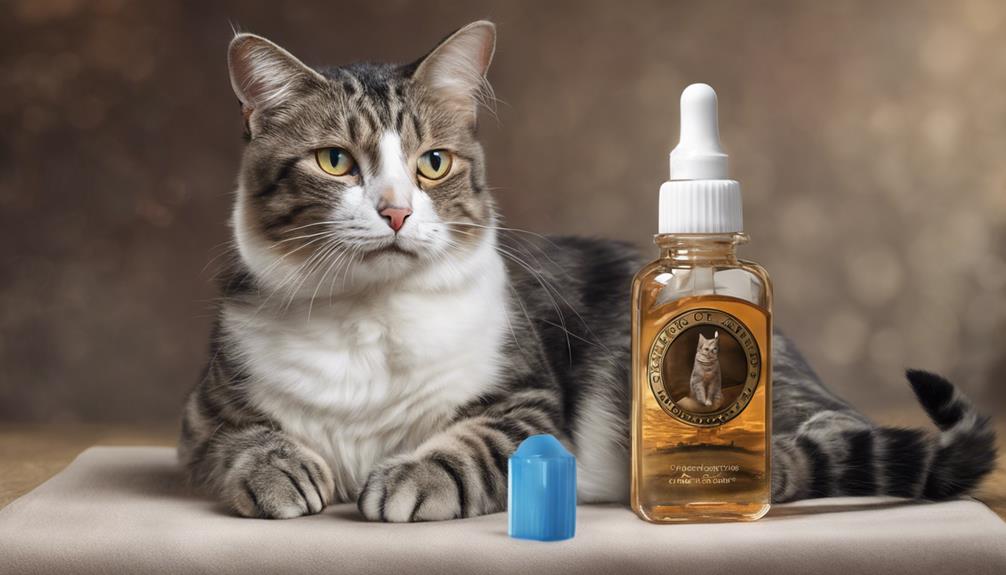
When addressing a cat's eye discomfort, it's important to gently clean any discharge around the eye using a warm, damp cloth. Squinting can be a sign of eye discomfort in cats, so it's essential to take steps to help alleviate their symptoms.
Avoid using over-the-counter eye drops without consulting a veterinarian first, as some medications may not be suitable for your feline friend. Keep a close eye on your cat's ocular health, looking out for any changes in appearance or behavior that could signal a worsening medical condition.
Creating a calm and stress-free environment can also aid in reducing your cat's eye discomfort. Remember, if your cat's eye issues persist or worsen, seek prompt veterinary care to guarantee they receive the proper treatment and care they need.
Frequently Asked Questions
What Does It Mean When a Cat Closes Its Eyes at You?
When a cat closes its eyes at you, it's a gesture of trust and affection. We reciprocate by slow-blinking back, fostering a bond. This mutual action builds comfort, relaxation, and security for both parties, strengthening our relationship.
What Does It Mean When a Cat Half Closes Its Eyes to You?
When a cat half-closes its eyes to us, it's showing trust and affection. We feel special knowing our feline friend is relaxed and content in our presence. Their squint is a sweet gesture of love.
Why Do Cats Squint When They're Mad?
When cats squint because they're mad, it's a defensive response. They do it to protect their eyes from threats and focus on potential dangers. Understanding this behavior helps avoid provoking further aggression and maintain a calm environment.
Why Do Cats Narrow Their Eyes?
We cats narrow our eyes to show comfort, relaxation, and trust. It's our way of expressing affection and bonding with humans. Understanding this behavior strengthens our communication and connection with our owners, fostering a deeper bond.
Can Squinting Eyes in Cats be a Sign of Hiccups or Seizures in Dogs?
Can squinting eyes in cats be a sign of hiccups or seizures in dogs? While it may seem unusual, the causes of dog hiccups differ from those in cats. Squinting eyes in cats typically indicate discomfort or pain, whereas dogs squint during a seizure. Understanding these distinctions helps ensure accurate diagnosis and appropriate treatment for our beloved pets.
Conclusion
To sum up, understanding why cats squint their eyes can help us identify potential issues and provide the necessary care for our feline friends. By recognizing signs of pain, infections, and other conditions, we can take steps to alleviate discomfort and promote their overall well-being.
Remember, a cat's eyes are windows to their health, so always keep an eye out for any changes and consult a veterinarian if needed. Your furry companion will thank you for it.
